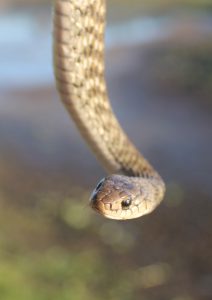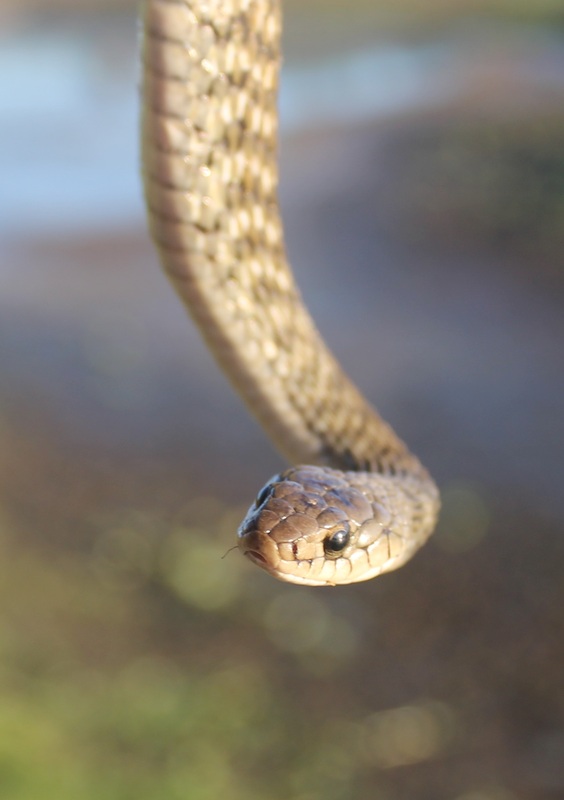Black Mamba Bio-Control Hoax
Making the rounds this week on the social media is an interesting but obviously fake article about black mambas (Dendroaspis polylepis). The article, found below, claims there is a plan to release 22,000 of these snakes in the Burdekin shire as part of a cane toad control program, however the article goes on to claim there is little evidence that mambas will have an impact on toad populations. Quite the hoax, and many were caught up by this one, due probably to snake-phobia or our often (unjustly) repulsive emotional associations with the subjects of both cane toad and snake.
Now, aside from the fact that I can find no record of a Mr William Matevellio in the Burdekin Council, aside from the fact that the mamba prefers warm blooded prey like mammals and birds, aside from the fact that the cane toad doesn’t occur naturally in the mamba’s diet (an thus it may suffer like other Australian snakes from ingesting cane toads), let’s look at this situation as a thought experiment. Why not, I ask, release a species to control the cane toad? We’ve done it before, releasing myxoma virus into the rabbit population, or Cacotblastis cactorum moth which destroyed 11 million hectares of invasive Prickly Pear cactus (Opuntia tomentosa) in just 10 years after its introduction in 1926. Biological control can work, however the cane toad is itself an example of biological control gone wrong. So, can we fix our failed attempt at biocontrol with more biocontrol? At what point do we throw our hands up in frustration and walk away as an invasive species goes beyond the point of eradication? Let’s examine the situation more closely, starting with the bouncy beasty itself.
Rhinella marina, the Cane Toad, is a truly amazing organism. Being an amphibian, it requires water to reproduce, however it can tolerate dry conditions much longer than many amphibians and can even tolerate salt water in estuarine conditions. It is a super generalist, taking an plethora of food types, even dead animal matter. This large land dwelling “true toad”, native throughout Central and South America, has been introduced throughout many pacific islands including Australia. These introductions were all intentional bio-control programs. The successful mid-1920 introductions to Puerto Rico for control of white grub may have in fact stabilized their sugar production and thus the entire economy, sending the scientific community into an uproar about the efficacy of cane toads as pest control. Since then cane toads have been introduced and become uncontrolled pest species in many locations, with limited success as a bio-control agent.
How did such a disaster unfold? There were scientists in the 1900’s too right? How then could such a miscalculation in a species’ dispersal ability, reproductive ability and general ecology come about?
In truth, the field of Invasion Biology (the study of invasive species and their ecological impacts) is still a burgeoning field. With the rapid advances computing, molecular biology, physics and a number of other fields, which picked up momentum in the 1900’s and is a phenomenon we live with and today take for granted, we often forget that science can be a slow process. In particular the naturalists, involved in the study of life histories, reproductive ecology and geographical distributions of species, often have to collect decades of observational data if statistically significant results are to be found (though their observational notes themselves may have huge behavioral significance). Invasion biology deals with all these matters at once, and more, including population genetics and gene flow of invasive species (and subsequent evolutionary/ecological consequences), and invasive vs. native species interactions such as resource competition and predation rates.
While the first “invasive species” may have been created during the time of human agriculture, passing along certain crop types and along with them invertebrates, or with the domestication, breeding and subsequent escape of certain animals and plants, it was human transport that kicked off the global invasions. Thanks to our wanderlust, many species from invertebrates to large herbivorous megafauna have successfully colonized new lands after travelling enormous distances, often by maritime transport. Using us as “vectors”, these species have transplanted themselves many times further than their natural dispersal mechanisms allow them. Unfortunately the potential impact of early human-mediated invasions, like that of pacific rats from island to island in traditional fishing boat, or of foxes, cats, rabbits and carp to Australia, was almost universally underestimated, a natural consequence of transport or an effort to make a new, unforgiving landscape more familiar. This viewpoint has of course swiftly changed, with ecologists now understanding much more about biodiversity, population thresholds, competition and the very real threat of extinction. While there is an impressive body of knowledge, it is nonetheless recent, and therefore, as a field based primarily on natural observation, incomplete. There remains not only knowledge gaps in our understanding of invasion biology, there’s also controversy on what exactly defines an invasive species, what word applies to what types of “invasions”, and a litany of other terminological inconsistencies.
With that caveat firmly secured to my forehead, lets continue with what we DO know about invasive species and biological control, and what we can do about the cane toad other than start a black mamba fan club! Biological control is a common practice, particularly in agriculture, where predatory or parasitoid insects such as small wasps are released to combat invading species. Despite our lack of understanding of invasive populations, we have a long history of importing organisms for biological control, with records as early as 304 A.D. in China to successfully protect mandarin trees. In retrospect, our early successes in importation and our lack of understanding was a potentially dangerous combination. Even today we struggle to model ecosystem function for they are complex systems with lots of interactions, making it difficult to predict the impact a certain change will have on overall function.
Now while monoculture crops aren’t exactly a natural environment, they’ve been intensely subjected to biocontrol efforts, and provide us with many simplified experiments in invasive species release. One interesting result is the efficacy of specialist versus generalist predators as control agents in different environments. As one expects, generalist invertebrates seem to be more successful in establishing in variable environments than specialists, being able to change prey types if the “pest” species they’re targeting is low in numbers. While this may be excellent for pest reduction, requiring a single introduction to establish a population, this is the exact characteristic that makes them potential invaders of natural environments. A buffer perimeter of a crop type unsuitable to a specialist may successfully stop them from escaping a crop area. This is not so for generalists, particularly if they have an innate dispersal ability such as flight, or use some other vector to mediate escape and transport. Specialists, with their more specific requirements, may often target a desired pest with greater fidelity and have little impact on natives, however many recurrent releases may be required for successful control.
The main characteristics an invasive species seems to require are thus a propensity for long distance movement (whether its own dispersal methods, human transplantation or accidental human-mediated transport), generalism in its feeding behaviour and environmental tolerances, and a large reproductive capacity. The latter is of great importance. All invaders are a subset of their original population, and are thus a reduced representation of their total genetic diversity. This “bottleneck” in diversity means newly established invasive populations are potentially susceptible to local extinction by changing environmental factors e.g. pathogens and climate. Rapid reproduction can increase population diversity by chromosome recombination and the accumulation of new mutations, while any further introductions, particularly from other source populations with different genetic variation, will help invasive populations persist. Plasticity and variation it seems are essential for a successfully establishing a beachhead population.
Genetics offers us a powerful tool to study these invasion bottlenecks. In fact, gene flow and genetic diversity data can indicate locations of origin, illuminate invasion pathways or vectors, find adaptive mutations and assess population demographics of an invasive population. Through genetics we can identify source populations and from there stop the introduction of further genetic diversity to the invasive population. Genetic diversity statistic may help assess which populations are more likely to persist and thus how to direct management effort. A further advantage of genetics is that it allows inferences of past and current demographic processes to be made without decades of field observation, a simple set of tissue samples will do.
Where does all this leave us, and what can we do as far as management of cane toads? Unfortunately, genetics can only do so much. We know the origin of the invasion, and genetic diversity is obviously sufficient for a viable population! In fact it was ecological modelling through field surveys and radiotracking, not genetics, that revealed a bizarre evolutionary consequence of the toads movements. It seems that as they spread west, those at the forefront of the invasion have longer legs, as would be expected. However, over the last 70 years, the toads with the longest legs have, by spatial dynamics alone, mated with those closer to the forefront, namely other long-legged frontier pushers. This self reinforcing process seems to override gene flow from the rest of the eastern, variably legged populations, resulting in what has been termed “spatially sorting evolution”, with strong selection pressure on toads at the front to have longer legs, making them the fastest spreading anuran on the planet. Another interesting result from these field studies is that these toads require man made water bodies (dams, wells etc.) to move through the hot, dry northwest corner of Australia. This then is where the stand must be made. An eradication program and barring of access to man made water sources may stop the spread at this important junction to WA.
As for introduction of biological control of cane toads, it seems an unequivocally poor solution. A successful generalist would most likely decimate local populations of native fauna. Australia is a very resource poor soil economy, thus species tend to have comparatively smaller populations, longer life spans and lower reproductive rates than most environments. Any new predator is unlikely to be well adapted to the delicate equilibrium of such conditions, including the black mamba. This east African coastal species is from one of the most productive continents in the world, where rapid plant growth leads to big populations of herbivorous prey, and thus conservatism is not necessary. It is thus a voracious opportunistic feeder, taking mostly warm blooded birds and mammals, though it does eat other snakes and lizards. Note that amphibians did not make the list, though they probably do make part of the juveniles’ diets. This does not bode well for our natives. They are also semi-arboreal, while cane toads are aquatic and terrestrial. I can easily envision the mamba competing heavily with taipans for marsupial prey like bandicoots, eating any native snakes and small mammals in its path, and feeding on fruit bat populations and birds which aren’t accustomed to a fast moving, venomous, arboreal predator such as the mamba, and ignoring the toads. Furthermore the hot tropical climate of northeast Queensland may be ideal for reproduction, after which the establishment is dependent on genetic variation for fluctuations in future conditions and environments. Estimates for mammals suggest around 300 are needed for a genetically viable population. I think 22,000 will do just fine.

Keelback (Tropidonophis mairii)
What then could successfully control the cane toad? More introductions to such a delicate ecosystem as Australia’s may do more harm then good. Another method of biological control using native species could be the key, namely augmentation (the release of naturally occurring predators) or conservation (efforts to promote the growth of natural predator populations). While most Australian species cannot deal with the toads Bufotoxins, there are some potential candidates for native biocontrol. The problem is, again, Australia’s delicate ecosystems. For example, the keelback snake (Tropidonophis mairii) has some resistance to Bufotoxins and is able to eat tadpoles and smaller toads with seemingly no ill effects. Would increasing this species’ numbers decrease toad numbers, or would all anurans suffer equally, including some of our already threatened native frogs? Or perhaps certain invertebrates, such as the water beetle Cybister godeffroyi and the water bugs Diplonychus rusticus and Lethocerus insulanus, which feed on cane toad tadpoles could be of use, however they too also feed on native tadpoles, fish and invertebrates. These species interactions would of course have to be experimentally tested in controlled environments before any release could be possible, then requiring further monitoring. Alternatively, the social learning of certain animals may be a huge advantage in this battle. Kookaburras and crows seem to have stumbled across a great solution to the toxins. They flip the toads on their back and eviscerate them, eating the internal organs and leaving the toxic skin and parotid glands untouched. It also seems that social learning is spreading this capability rapidly, perhaps even across species (crow to kookaburra). Would releasing toad-wise birds into the northeast corner and further east spread the new “culture” of “toad-flipping” through, dare I say it, tweets? My apologies for the anthropomorphism.
Moving on, this idea has even been applied to mammals. The endangered Northern Quoll (Dasyurus hallucatus) took a severe blow when toads reached Kakadu, with many local populations decimated or extinct. A bold project between the University of Technology Sydney and the Australian Wildlife Conservancy is aiming to teach quolls to be “toad-smart” by feeding them non-lethal amounts of cane toad, teaching them aversion to the taste and smell. It is hoped that the recent releases will result in a knowledge transmission horizontally to other quolls and vertically down to the next generations of offspring, eventually creating a totally toad-smart population. While this won’t eradicate the toad, it may save the Northern Quoll, and that’s no small victory for these enigmatic marsupials.
These are some of the changes which seem to be more common as the years go by. Though still doing major damage to frog, mammal, reptile and even bird communities, the true population boom of the toads is over. They’re now an established pest, and while still a huge ecological disaster for biodiversity, there seems to be some momentum swinging in the natives favor. There are reports, unsubstantiated, of red bellied black snakes and even other small mammals eating toads, the former developing some sort of immunity, the latter killing them and like the birds, eviscerating them, eating just the internal organs. While immunity to the toxins seems to be a fantastic solution, this is nonetheless an adaptive evolutionary response, and the toads themselves may then be under pressure to evolve higher toxicity, leading to a conflagration of weaponry, an evolutionary arms race, leading to highly resistant black snakes, but hugely toxic toads (obviously undesirable). It is my hope that the more advanced brains of birds and mammals, and the social evolution they are capable of, can outpace the newly introduced toad before an arms race can gain momentum. Perhaps with our assistance, through release of toad-smart fauna of guilds, we can teach our environment to fight back and convert the toad from pest to prey, or at least off the menu. Either that or the toads will adapt very, very rapidly and we end up with armor plated toads, extremely long-legged, with venom-spraying fangs, wings, and a brain the size of a dolphin. Super-camouflaged ninja toads of death, basically. Not saying they will. Just saying its possible…
Cheers,
Janne
www.snakeoutbrisbane.com.au


